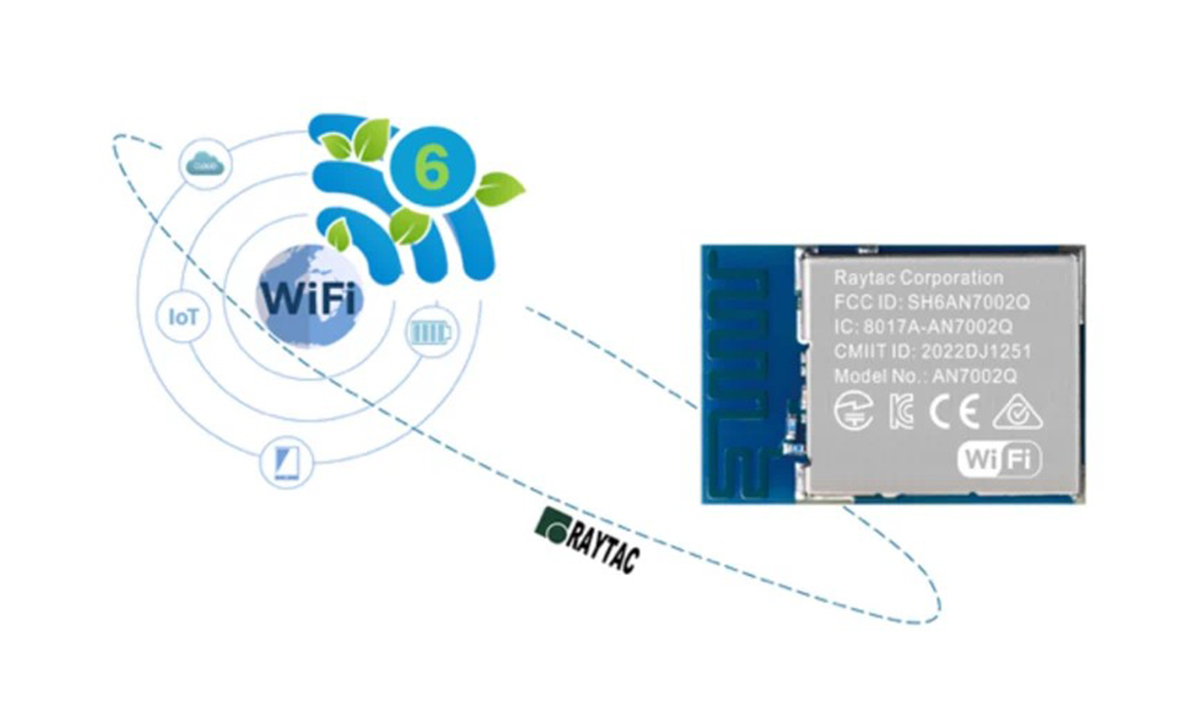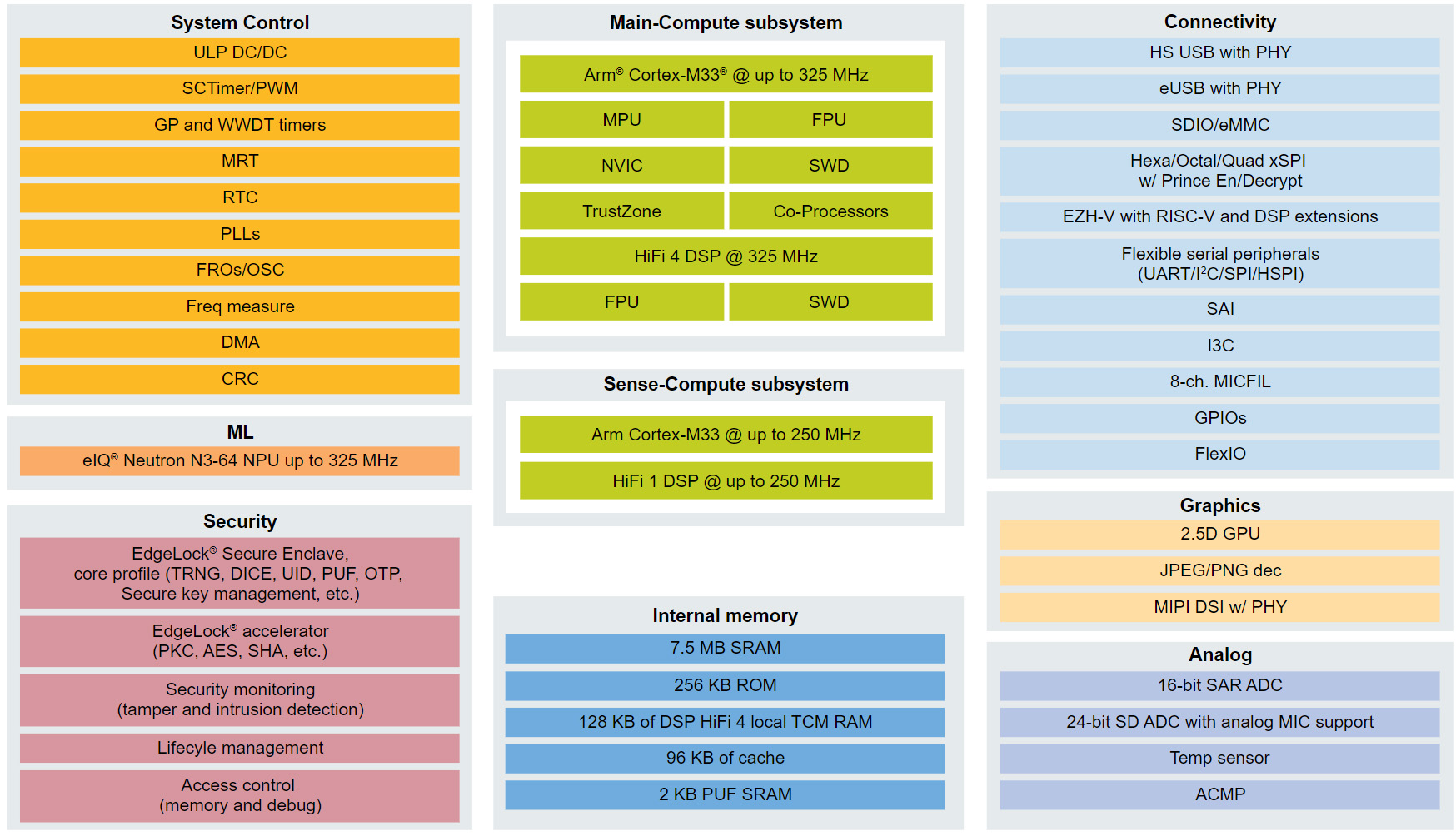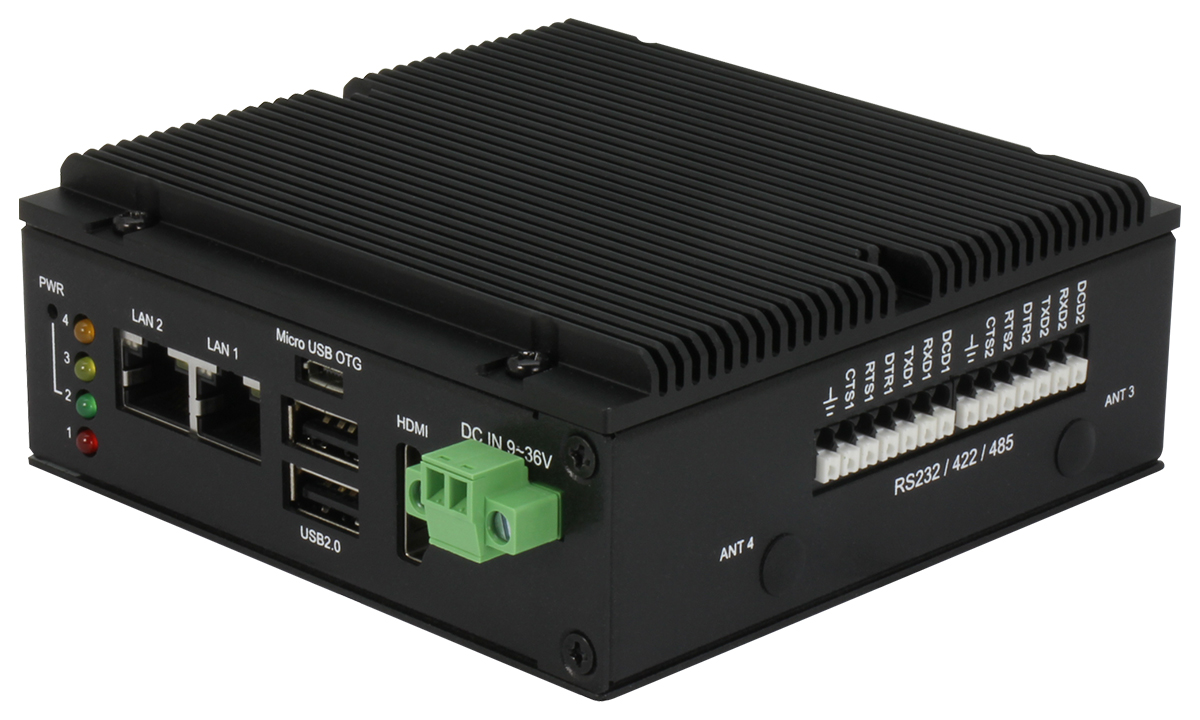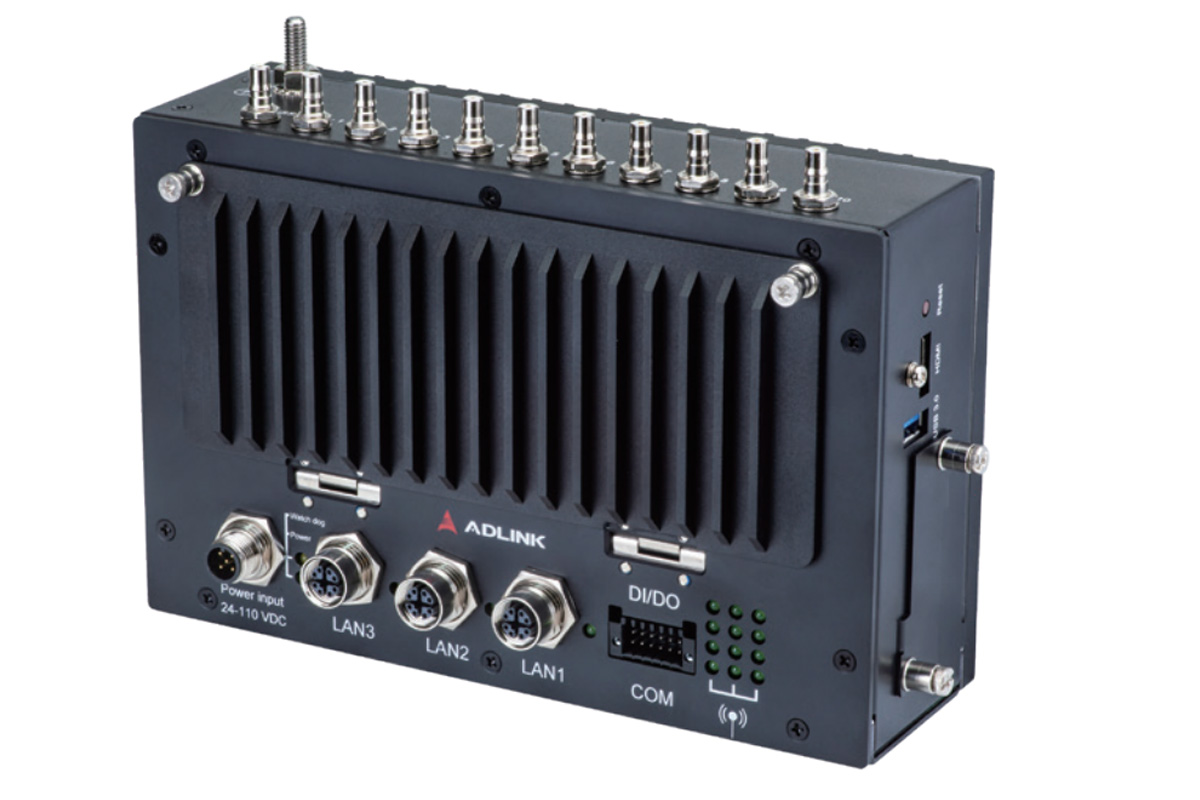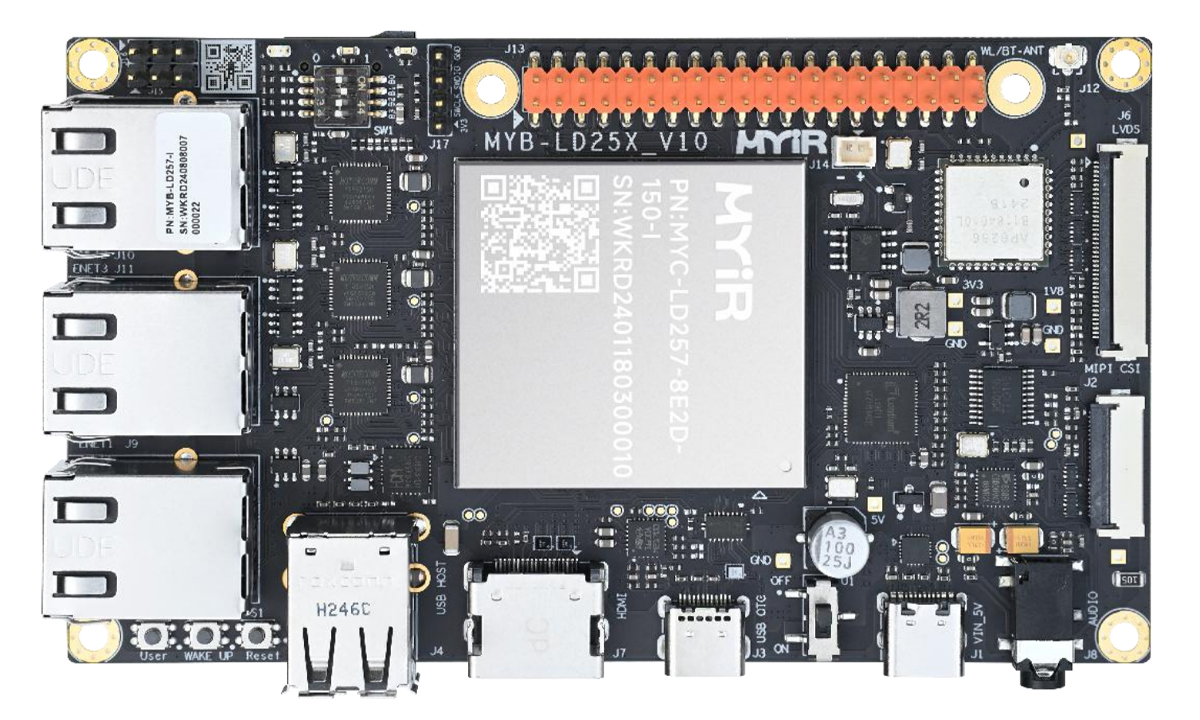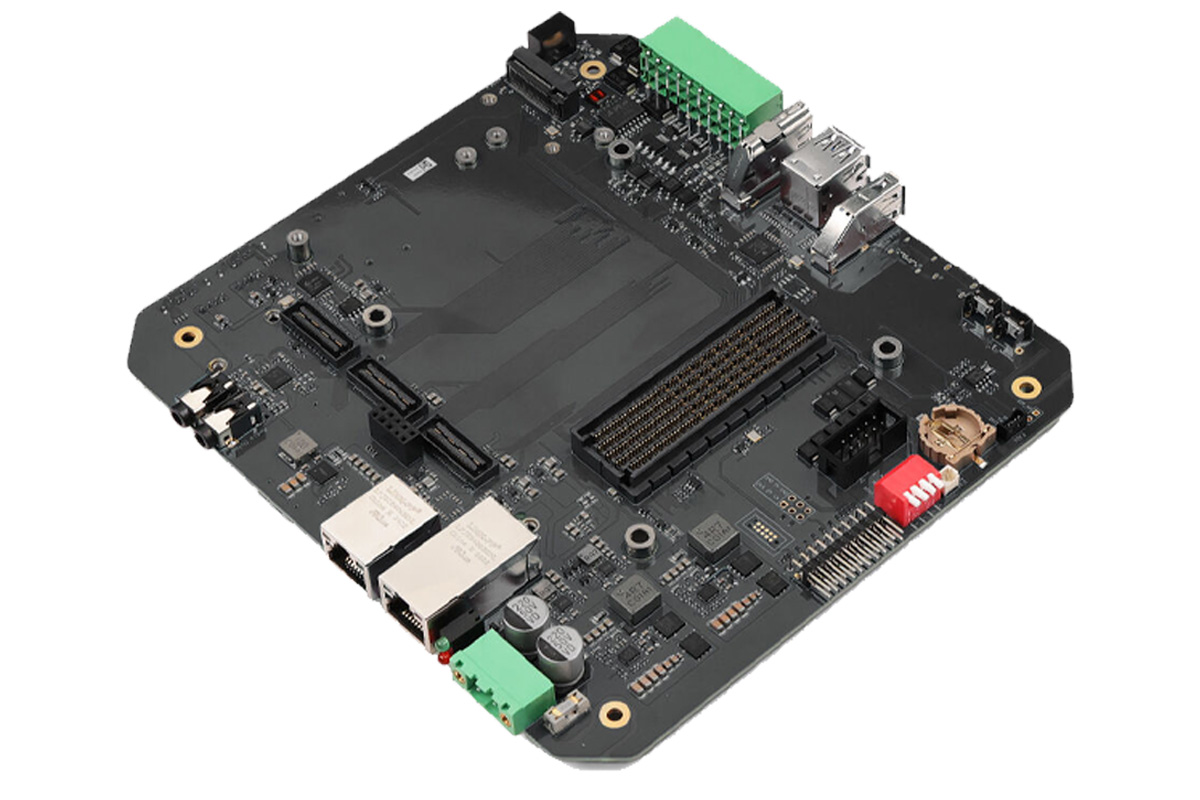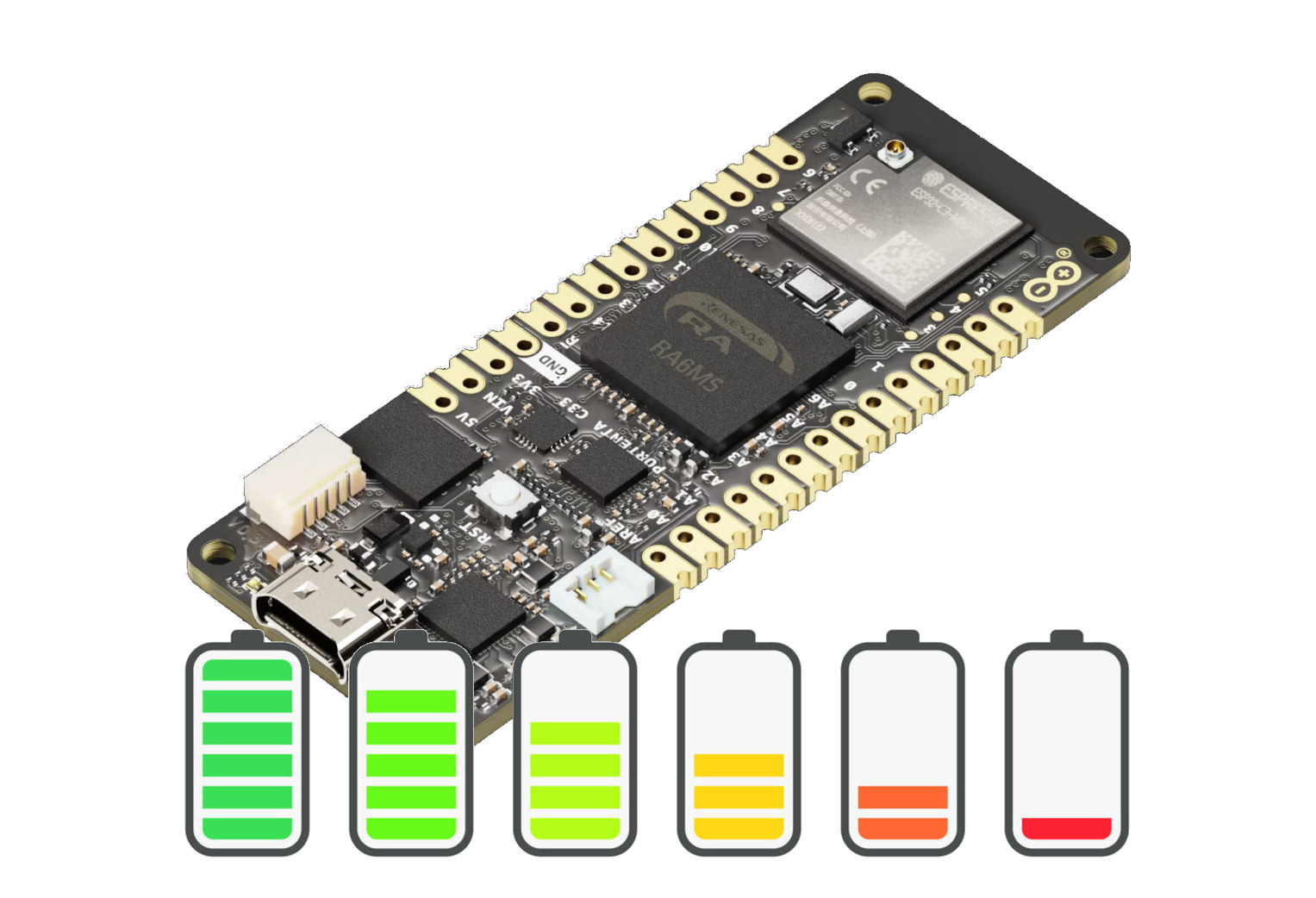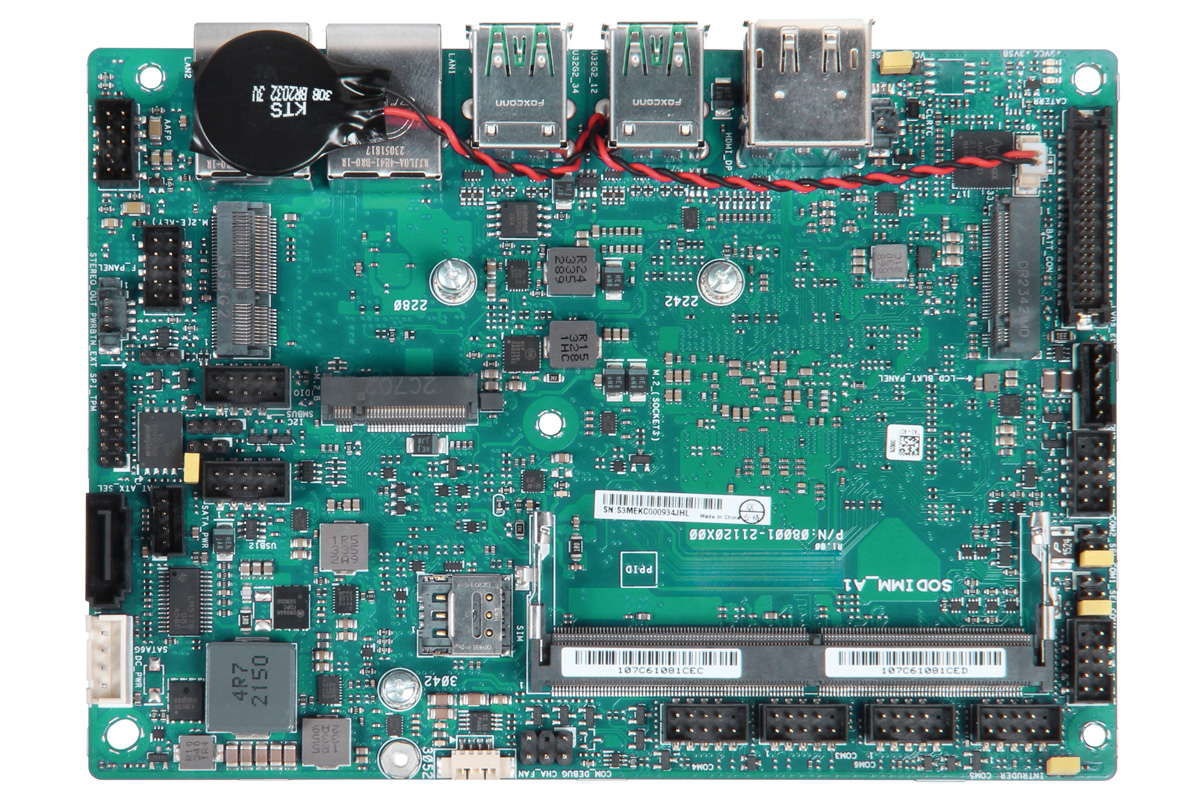IoT solutions company Raytac has introduced the AN7002Q Wi-Fi 6 module series, which integrates Nordic Semiconductor’s nRF7002 chipset and is designed for Industrial IoT, smart home, healthcare, consumer electronics, and automotive applications. They can be paired with Raytac’s MDBT53 Bluetooth LE modules based on the nRF5340 multiprotocol SoC, supporting Wi-Fi and Bluetooth LE solutions. The AN7002Q is a low-power Wi-Fi 6 module supporting dual-band 2.4 GHz and 5 GHz operation with a maximum PHY data rate of 86 Mbps (MCS7). It is compatible with IEEE 802.11ax, a/b/g/n/ac standards, and connects to a host SoC or MCU via SPI or QSPI interfaces. The module also supports coexistence with Bluetooth LE, Thread, and Zigbee systems, making it ideal for IoT applications. Previously, we covered the Abluetech PTR7002, a low-power wireless module based on the Nordic Semiconductor nRF7002. The PTR7002 has a slightly larger size and offers more GPIO options, while the AN7002Q […]
NXP i.MX RT700 dual-core Cortex-M33 AI Crossover MCU includes eIQ Neutron NPU and DSPs
NXP has recently announced the release of NXP i.MX RT700 RT700 AI crossover MCU following the NXP i.MX RT600 series release in 2018 and the i.MX RT500 series introduction in 2021. The new i.MX RT700 Crossover MCU features two Cortex-M33 cores, a main core clocked at 325 MHz with a Tensilica HiFi 4 DSP and a secondary 250 MHz core with a low-power Tensilica HiFi 1 DSP for always-on sensing tasks. Additionally, it integrates a powerful eIQ Neutron NPU with an upgraded 7.5 MB of SRAM and a 2D GPU with a JPEG/PNG decoder. These features make this device suitable for applications including AR glasses, hearables, smartwatches, wristbands, and more. NXP i.MX RT700 specifications: Compute subsystems Main Compute Subsystem Cortex-M33 @ up to 325 MHz with Arm TrustZone, built-in Memory Protection Unit (MPU), a floating-point unit (FPU), a HiFi 4 DSP and supported by NVIC for interrupt handling and SWD […]
AAEON SRG-CM4 IoT gateway features Raspberry Pi CM4 SoM for industrial applications
AAEON SRG-CM4 is an IoT gateway based on the Raspberry Pi Compute Module 4 (CM4) with 1GB to 8GB of RAM and 8GB to 32GB of eMMC storage, all powered by the Broadcom BCM2711 quad-core Cortex-A72 SoC. The gateway features a modular chassis, maintaining the compact size and industrial-grade features typical of AAEON’s edge gateway products, making it ideal for various embedded applications. In terms of connectivity, the SRG-CM4 offers two switchable serial ports supporting RS-232/422/485, with an optional isolated RS-485 port, CAN 2.0 A/B, and two isolated DI/DO. Additional interfaces include two Gigabit Ethernet RJ45 ports, two USB 2.0 ports, and an HDMI 1.4 video output. The device operates within a wide temperature range of -20°C to 70°C and supports a DC 9V to 36V power input, ensuring reliability in industrial environments. We previously covered the reComputer R1025-10, a Raspberry Pi CM4-based DIN Rail industrial gateway with optional wireless […]
ADLINK AVA-1000 is a rugged EN50155-compliant T2G gateway for railway and industrial applications
The ADLINK AVA-1000 T2G gateway is a rugged, EN50155-compliant T2G (Train-to-Ground) gateway designed for railway and industrial environments. Powered by a choice of NXP i.MX8M Plus Quad Cortex-A53 processor or an Intel Processor N50 Alder Lake-N processor. The i.MX8M Plus model is equipped with up to 8GB LPDDR4 and a 64GB eMMC flash whereas the Alder Lake variant features up to 4GB LPDDR5 memory and a 32GB eMMC flash. In terms of connectivity, the gateway features three M12 GbE ports and supports a wide range of options including 5G, WiFi 6, and GNSS. The AVA-1000 T2G gateway’s fanless design, wide operating temperature range, and 24-110V DC input ensure reliable operation in industrial environments. Additionally, its compliance with EN50155 and other industrial standards makes it ideal for various industrial applications. AVA-1000 T2G gateway specifications System Processor (multiple options) NXP i.MX8M Plus quad-core Cortex-A53 processor @ up to 1.8 GHz with Cortex-M7 […]
MYiR Tech MYC-LD25X – A compact STM32MP25 system-on-module running Debian 12
MYiR Tech’s MYC-LD25X is a compact 39x37mm system-on-module built around the STMicro STM32MP25 dual-core Cortex-A35 SoC running at 1.5GHz with a Cortex-M33 core, and an NPU capable of 1.35 TOPS. The module comes with up to 2GB LPDDR4 RAM, 8GB eMMC storage, and a range of connectivity options, including Gigabit Ethernet, USB, CAN FD, UART, and SPI. Designed for industrial HMI, edge computing, energy systems, and automation, the MYC-LD25X is suitable for high-performance applications in these fields. Previously, we covered other development boards from MYiR, including the MYD-J7A100T, MYD-YG2UL, MYD-YG2LX, and MYD-J1028X. We also wrote about other STM32MP25-based system-in-package and system-on-module namely the Digi ConnectCore MP25 and Octavo OSD32MP2. Feel free to check them out if you’re interested. MYC-LD25X STM32MP25-based System-On-Module MYC-LD25X specifications: SoC – STMicro STM32MP257D processor CPU – Dual-core Arm Cortex-A35 64-bit RISC core operating at up to 1.5 GHz MPU – 32-bit Arm Cortex-M33 RISC core clocked at […]
reServer Industrial J501 – An NVIDIA Jetson AGX Orin carrier board with 10GbE, 8K video output, GMSL camera support
Seeed Studio’s reServer Industrial J501, a Jetson AGX Orin carrier board designed for building Edge AI systems. With up to 275 TOPS of exceptional AI performance, this carrier board is designed for advanced robotics and edge AI applications for industrial environments. The carrier board features GbE and 10GbE LAN via RJ45 ports, three USB 3.1 ports, an HDMI 2.1 output, and multiple M.2 slots for expansion, including support for wireless connectivity via the M.2 Key B socket. Additionally, it has support for 8K video decoding and up to 8 GMSL cameras via an optional extension board. reServer Industrial J501 Jetson AGX Orin carrier board specification System-on-Module (one or the other) SoM – NVIDIA Jetson AGX Orin 64GB with CPU – 12-core Arm Cortex-A78AE v8.2 64-bit processor with 3MB L2 + 6MB L3 cache GPU / AI accelerators NVIDIA Ampere architecture with 2048 NVIDIA CUDA cores and 64 Tensor Cores @ […]
Arduino releases a power management library for Arduino Pro modules to optimize power consumption
Arduino has released a new power management library designed for Arduino Pro modules to help users monitor battery usage, fine-tune charging parameters, and optimize the power consumption of their Arduino code by notably enabling sleep and standby modes on supported devices. Currently, the Arduino Portenta H7 boards, the Arduino Portenta C33, and the Nicla Vision module are supported by the new power management library. The company explains some boards consume under 100 microamperes in deep sleep mode enabling months or even years of continuous runtime on a single charge, so making use of those features is important to lower the power consumption of battery-powered IoT devices and wearables. Arduino power management library key features: Battery monitoring – Reports battery metrics such as voltage, current, percentage, and temperature. Battery health tracking – Monitors battery health with detailed insights into temperature and reported capacity. Charging control – Monitors and adjusts charging parameters […]
Portwell PEB-2274 3.5-inch fanless Intel Atom x6425E SBC offers triple display support, dual GbE, three M.2 sockets, and more
Portwell has recently launched PEB-2274, a 3.5-inch fanless SBC built around Intel Atom x6425E Elkhart Lake SoC. Key features include up to 32GB DDR4 memory, two Gigabit Ethernet ports, three M.2 sockets for storage and expansion, and a wide 9V to 36V DC power input. Additionally, it has various display interfaces (HDMI, DP, LVDS), multiple serial ports, USB, and audio options. We have already covered several other 3.5-inch inch Elkhart Lake SBCs with dual Ethernet ports including the Avalue ECM-EHL 3.5-inch SBC, Congatec Conga-PA7 Pico-ITX board, the iBase IB836 3.5-inch SBC, and the AAEON GENE-EHL5 SBC. All these boards support dual Ethernet and some of them have support for triple ethernet ports. But what’s unique about the PEB-2274 is that it has dual GbE ethernet, triple display, and a design specifically for industrial applications. Portwell PEB-2274 specifications: SoC – Intel Atom x6425E quad-core processor @ 2.00 GHz / 3.00 GHz […]


